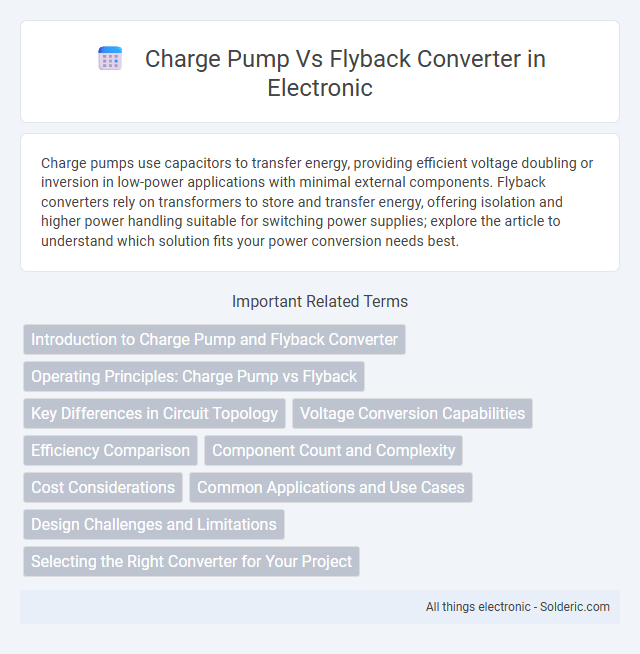Charge pumps use capacitors to transfer energy, providing efficient voltage doubling or inversion in low-power applications with minimal external components. Flyback converters rely on transformers to store and transfer energy, offering isolation and higher power handling suitable for switching power supplies; explore the article to understand which solution fits your power conversion needs best.
Comparison Table
| Aspect | Charge Pump | Flyback Converter |
|---|---|---|
| Operation | Capacitor-based voltage conversion by switching capacitors | Transformer-based switched-mode power supply with energy storage |
| Typical Voltage Range | Low to medium voltage (usually below 15V) | Wide voltage range, including high voltage outputs |
| Efficiency | Moderate efficiency, decreases with load | High efficiency, especially at higher power levels |
| Power Output | Low to moderate power (mW to a few watts) | Moderate to high power (watts to hundreds of watts) |
| Complexity | Simple circuit, fewer components | More complex, requires transformer and additional circuitry |
| Size | Compact, no magnetic components | Bulky due to transformer and associated components |
| Noise | Low electromagnetic interference (EMI) | Higher EMI due to switching and transformer operation |
| Applications | Battery-powered devices, low-power voltage doubling/inversion | Power supplies, isolated DC-DC conversion, larger load regulation |
Introduction to Charge Pump and Flyback Converter
Charge pumps and flyback converters are essential components in power supply design, each serving distinct voltage conversion needs. Charge pumps utilize capacitors to transfer energy and boost voltage efficiently without inductors, ideal for low-power applications. Flyback converters employ transformers and switches to provide electrical isolation and handle higher power levels with flexible voltage regulation.
Operating Principles: Charge Pump vs Flyback
Charge pumps operate by transferring energy through capacitors using switching elements to create higher or inverted voltage levels without inductors. Flyback converters utilize a transformer to store energy during the switch-on phase and release it to the output during the switch-off phase, enabling galvanic isolation and multiple output voltages. Charge pumps are efficient for low-power, low-voltage applications, whereas flyback converters excel in high-voltage, high-power scenarios requiring isolation.
Key Differences in Circuit Topology
Charge pumps use capacitors to store and transfer energy through switches in a simple, switch-capacitor configuration with no inductors, making them compact and suitable for low-power applications. Flyback converters employ an isolation transformer with a magnetically coupled inductor to store energy during the switch-on period and release it to the output during the switch-off phase, enabling voltage conversion with electrical isolation. The key difference in circuit topology lies in the charge pump's reliance on capacitive charge transfer versus the flyback converter's magnetic energy storage and transformer isolation.
Voltage Conversion Capabilities
Charge pumps efficiently convert low voltages to modestly higher voltages using capacitors for charge transfer, making them ideal for small voltage step-up or inversion tasks. Flyback converters handle a wider voltage range, providing isolation and efficiently stepping voltages up or down through transformer-based energy storage. Your choice depends on the voltage conversion range and isolation requirements of the application.
Efficiency Comparison
Charge pumps generally offer higher efficiency in low-power, low-voltage applications due to their simple design and fewer components, resulting in minimal energy loss. Flyback converters excel in handling higher power levels and provide better efficiency across a wider input voltage range, thanks to their ability to store and transfer energy via magnetic components. Your choice between the two should consider the required power level, load conditions, and efficiency targets to optimize overall system performance.
Component Count and Complexity
Charge pumps utilize fewer external components, primarily capacitors and diodes, resulting in a simpler and more compact design compared to flyback converters. Flyback converters require transformers, switches, inductors, and more complex control circuitry, increasing both component count and design complexity. The reduced component count of charge pumps often leads to lower manufacturing costs and smaller PCB footprints, ideal for low power applications.
Cost Considerations
Charge pumps offer lower cost benefits due to their simple circuitry and fewer components, making them ideal for applications with limited budget constraints. Flyback converters, although more expensive because of their transformers and complex control circuits, provide higher power efficiency and better load regulation in high-voltage applications. When evaluating cost considerations, the trade-off between initial hardware expenses and long-term energy savings determines the optimal choice for power supply design.
Common Applications and Use Cases
Charge pumps are commonly used in low-power applications requiring voltage multiplication or inversion, such as in LCD biasing, EEPROM programming, and small battery-operated devices. Flyback converters excel in isolated power supplies and medium-to-high power applications, including industrial equipment, LED drivers, and telecom power systems. Their ability to provide electrical isolation and wide input voltage range makes flyback converters suitable for adapters and battery chargers.
Design Challenges and Limitations
Charge pumps face design challenges such as limited output current and voltage scaling constraints due to capacitor size and switching frequency, making them less ideal for high-power applications. Flyback converters encounter limitations like complexity in transformer design, electromagnetic interference (EMI) management, and the need for precise control to maintain efficiency and voltage regulation under varying loads. Both technologies require careful consideration of component stresses and thermal management to ensure reliable operation in their respective use cases.
Selecting the Right Converter for Your Project
Charge pumps offer compact, cost-effective solutions for low-power applications requiring simple voltage doubling or inversion, ideal for space-constrained designs. Flyback converters handle higher power levels with efficient isolation and voltage regulation, making them suitable for complex systems requiring multiple output voltages. Selecting the right converter depends on power requirements, efficiency targets, size constraints, and isolation needs specific to your project.
charge pump vs flyback converter Infographic

 solderic.com
solderic.com